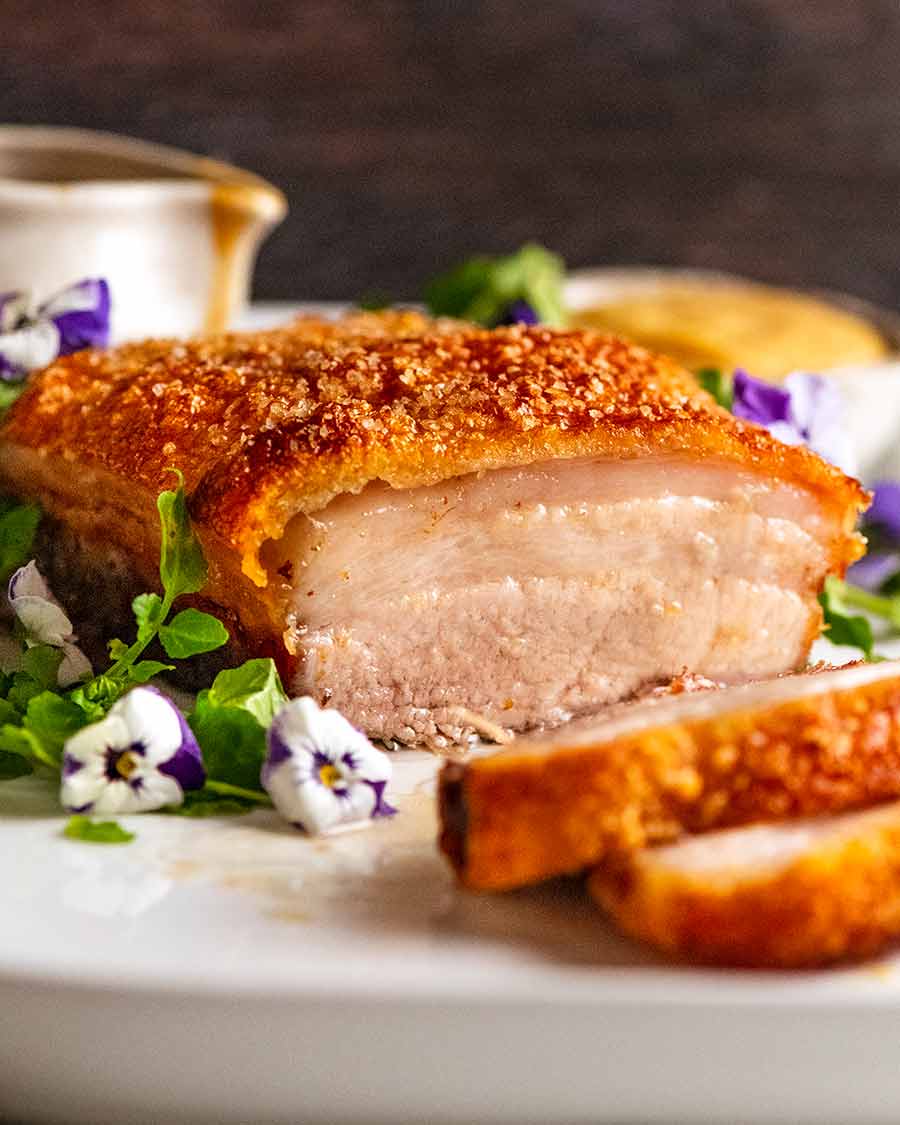Roasted Pork Belly: Crispy Skin, Cooking Techniques, and Perfect Serving Tips
Roasted pork belly, a culinary delight, originates from the belly of the pig. This cut includes layers of meat and fat, creating its signature tenderness and juiciness. Each strip averages 12-20 inches long, 6-12 inches wide, and up to 2 inches thick. The meat’s composition makes it ideal for slow roasting, which renders the fat and crisps the skin. Ensure to score the skin before roasting to maximize crackling and flavor penetration.
Varieties Across Cultures
Different cultures have unique methods to prepare roasted pork belly. In Chinese cuisine, it’s known as “Siu Yuk” and often marinated with spices and Chinese five-spice powder before roasting. Filipino cuisine features “Lechon Kawali,” deep-frying the belly post-roasting for an extra crispy texture. In Italian culinary traditions, “Porchetta” involves stuffing the belly with herbs and spices, then slow-roasting it. These variations showcase the versatility of pork belly, catering to diverse palates and culinary practices.
Ingredients for Perfect Roasted Pork Belly
Selecting the Right Meat
Choose fresh pork belly with an even layer of meat and fat. Look for firm, pinkish-red meat and creamy white fat. Ensure the skin is intact for optimal crispiness. Ideal dimensions range from 12-20 inches long and 6-12 inches wide. Meat thickness should be up to 2 inches. Purchase high-quality cuts from reputable sources for the best results.
Essential Herbs and Spices
Use a blend of herbs and spices to enhance the flavor of the roasted pork belly. Essential ingredients include:
- Salt and Pepper: Seasoning the meat evenly.
- Garlic: Minced or powdered, adds depth.
- Thyme: Fresh or dried, provides aromatic essence.
- Rosemary: Fresh sprigs infuse a woody flavor.
- Paprika: Smoked or sweet, enhances color and taste.
- Bay Leaves: Add subtle complexity.
These herbs and spices ensure the roasted pork belly has a rich, flavorful profile. Combining them with the right meat selection, you create a perfect roasted pork belly.
Preparing Roasted Pork Belly
Steps to Clean and Prepare
First, select a fresh piece of pork belly with an even layer of fat and meat. Rinse the pork belly under cold water to remove any surface impurities. Pat dry with paper towels until thoroughly dry. This ensures better seasoning adhesion and crisping.
Score the skin of the pork belly using a sharp knife. Make shallow cuts in a cross-hatch pattern, avoiding cutting through to the meat. Scoring allows the seasonings to penetrate and helps the fat render properly during roasting.
Prepare a seasoning blend consisting of salt, pepper, garlic powder, thyme, rosemary, and paprika. Rub the mixture evenly on all sides of the pork belly, ensuring it reaches the scored cuts. Let the seasoned pork belly sit uncovered in the refrigerator for at least two hours, allowing the skin to dry further and the flavors to meld.
Tips for Crispy Skin
Ensure the skin is completely dry before roasting. Moisture on the skin will prevent it from becoming crispy. Pat the skin dry again just before placing it in the oven if necessary.
Preheat the oven to a high temperature, around 450°F (232°C). Start roasting at this high heat for the first 30 minutes. High initial heat helps to blister and crisp the skin quickly.
After the initial high-temperature roasting, reduce the oven temperature to 350°F (177°C). Continue roasting for another hour or until the meat is tender and the skin is golden brown. Use a meat thermometer to ensure the internal temperature reaches at least 160°F (71°C).
For extra crispy skin, switch the oven to broil for the last 5 to 10 minutes of cooking. Watch closely to prevent burning. Allow the roasted pork belly to rest for 10 minutes before carving to let the juices redistribute, ensuring juicy meat under the crispy skin.
Cooking Techniques
Oven Roasting
Use oven roasting to achieve evenly cooked pork belly with crispy skin. Preheat your oven to 425°F (220°C) for optimal results. Place the prepared pork belly on a wire rack over a baking sheet to allow for even air circulation. This helps render out the fat and ensures crispy skin.
Start by roasting the pork belly at high heat (425°F) for 30 minutes. Reduce the temperature to 350°F (175°C) and continue cooking for 1.5 to 2 hours, depending on the size of the pork belly. Use a meat thermometer to check the internal temperature, which should reach 165°F (75°C) for safe consumption. Finish the process by broiling the pork belly for 5-10 minutes to achieve a golden, crispy skin.
Alternative Methods
Explore various techniques if you prefer not to use the oven.
- Slow Cooker: Slow cooking results in tender, flavorful pork belly. Season the pork belly, place it in the slow cooker skin-side up, and cook on low for 8-10 hours. Finish by broiling in the oven for ultimate crispiness.
- Air Fryer: Use an air fryer to achieve a crispy, less greasy pork belly. Preheat the air fryer to 400°F (200°C). Cook the pork belly in batches for about 25-30 minutes, flipping halfway through. This method reduces cooking time while ensuring crispy results.
- Grilling: Grilling imparts a smoky flavor to the pork belly. Grill the meat over indirect heat at medium temperature for about 1.5 to 2 hours. Use direct heat for the final 15 minutes to crisp up the skin.
These methods offer flexibility while providing fantastic results for your roasted pork belly.
Serving Suggestions
Pairing Side Dishes
Enhance the flavor of roasted pork belly with thoughtfully chosen side dishes. Consider offering a mix of starch, vegetables, and refreshing elements to create a balanced meal.
- Starches: Serve roasted pork belly with garlic mashed potatoes, creamy polenta, or rice pilaf. These starchy sides balance the rich flavors of the pork.
- Vegetables: Add grilled asparagus, roasted Brussels sprouts, or a fresh garden salad. These offer a crisp contrast to the pork’s texture.
- Refreshing Elements: Include apple slaw, pickled vegetables, or a citrus salad. These refreshing sides cut through the pork’s richness, providing a palate cleanser.
Presentation Tips
Presenting roasted pork belly well elevates the dining experience. Focus on the visual appeal, texture, and arrangement for a delightful presentation.
- Slicing: Slice the pork belly into even portions to ensure consistent presentation. Each piece should display the layers of crispy skin, succulent meat, and fat.
- Plating: Use a clean white plate to highlight the dish. Arrange the pork belly slices in a slightly angled stack to showcase their textures.
- Garnishing: Garnish with fresh herbs like rosemary, thyme, or parsley. These vibrant greens add a pop of color and enhance the aroma.
By carefully pairing side dishes and focusing on presentation, you can create an unforgettable dining experience centered around roasted pork belly.
Conclusion
Roasted pork belly is more than just a dish; it’s a culinary experience that brings together flavors, textures, and traditions. Whether you’re following classic preparation methods or experimenting with modern cooking techniques, achieving that perfect crispy skin is always rewarding. Pair it with complementary sides and present it beautifully to impress your guests. Your journey with roasted pork belly doesn’t end in the kitchen; it extends to the dining table, where every bite is a celebration of your culinary skills. Enjoy the process and savor the results!





